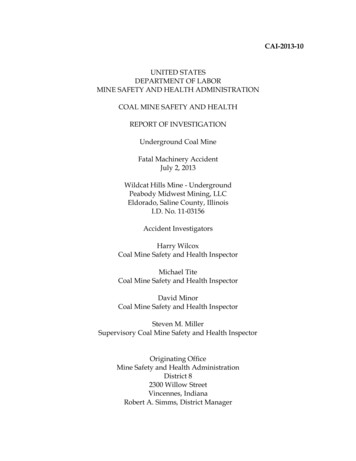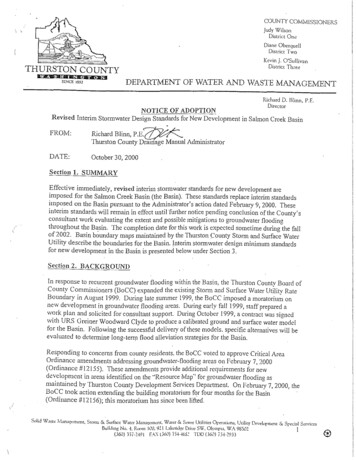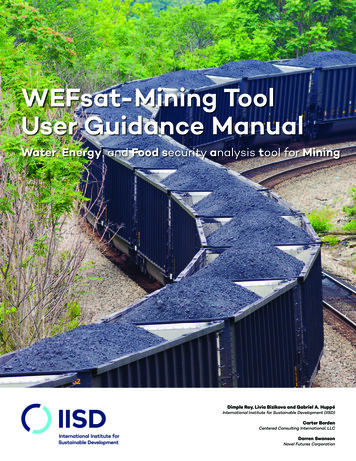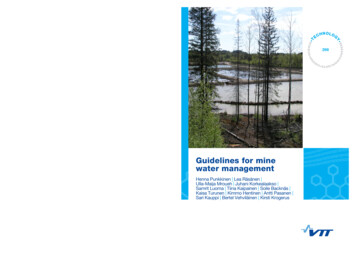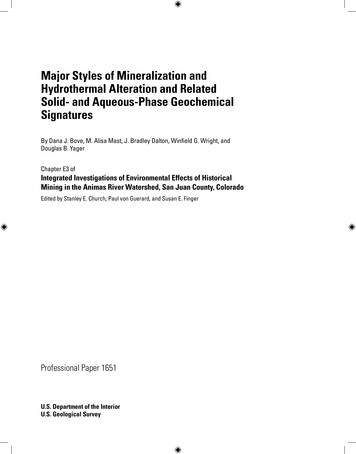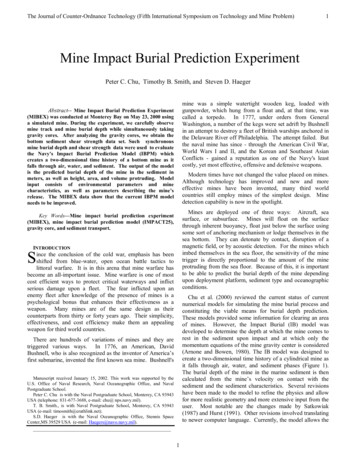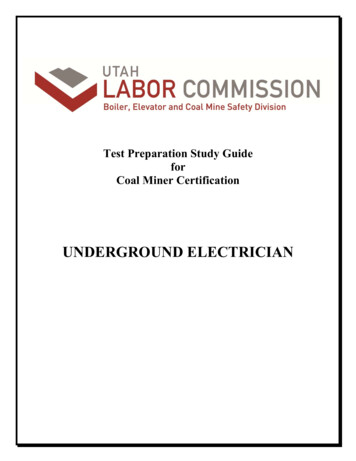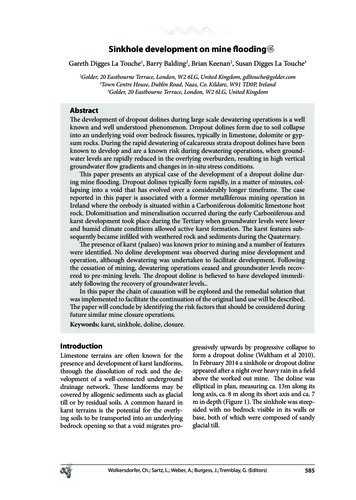
Transcription
Sinkhole development on mine floodingGareth Digges La Touche1, Barry Balding2, Brian Keenan2, Susan Digges La Touche3Golder, 20 Eastbourne Terrace, London, W2 6LG, United Kingdom, gdltouche@golder.com2Town Centre House, Dublin Road, Naas, Co. Kildare, W91 TD0P, Ireland3Golder, 20 Eastbourne Terrace, London, W2 6LG, United Kingdom1AbstractThe development of dropout dolines during large scale dewatering operations is a wellknown and well understood phenomenon. Dropout dolines form due to soil collapseinto an underlying void over bedrock fissures, typically in limestone, dolomite or gypsum rocks. During the rapid dewatering of calcareous strata dropout dolines have beenknown to develop and are a known risk during dewatering operations, when groundwater levels are rapidly reduced in the overlying overburden, resulting in high verticalgroundwater flow gradients and changes in in-situ stress conditions.This paper presents an atypical case of the development of a dropout doline during mine flooding. Dropout dolines typically form rapidly, in a matter of minutes, collapsing into a void that has evolved over a considerably longer timeframe. The casereported in this paper is associated with a former metalliferous mining operation inIreland where the orebody is situated within a Carboniferous dolomitic limestone hostrock. Dolomitisation and mineralisation occurred during the early Carboniferous andkarst development took place during the Tertiary when groundwater levels were lowerand humid climate conditions allowed active karst formation. The karst features subsequently became infilled with weathered rock and sediments during the Quaternary.The presence of karst (palaeo) was known prior to mining and a number of featureswere identified. No doline development was observed during mine development andoperation, although dewatering was undertaken to facilitate development. Followingthe cessation of mining, dewatering operations ceased and groundwater levels recovered to pre-mining levels. The dropout doline is believed to have developed immediately following the recovery of groundwater levels.In this paper the chain of causation will be explored and the remedial solution thatwas implemented to facilitate the continuation of the original land use will be described.The paper will conclude by identifying the risk factors that should be considered duringfuture similar mine closure operations.Keywords: karst, sinkhole, doline, closure.IntroductionLimestone terrains are often known for thepresence and development of karst landforms,through the dissolution of rock and the development of a well-connected undergrounddrainage network. These landforms may becovered by allogenic sediments such as glacialtill or by residual soils. A common hazard inkarst terrains is the potential for the overlying soils to be transported into an underlyingbedrock opening so that a void migrates pro-gressively upwards by progressive collapse toform a dropout doline (Waltham et al 2010).In February 2014 a sinkhole or dropout dolineappeared after a night over heavy rain in a fieldabove the worked out mine. The doline waselliptical in plan, measuring ca. 13m along itslong axis, ca. 8 m along its short axis and ca. 7m in depth (Figure 1). The sinkhole was steepsided with no bedrock visible in its walls orbase, both of which were composed of sandyglacial till.Wolkersdorfer, Ch.; Sartz, L.; Weber, A.; Burgess, J.; Tremblay, G. (Editors)9 Geochemistry Hydogeology BOOK.indb 5855859/3/18 12:22 PM
11th ICARD IMWA MWD Conference – “Risk to Opportunity”Figure 1 Sinkhole a few days after development.GeologyThe area is underlain by a sequence of partiallydolomitised Lower Carboniferous limestoneswhich was subject to extensive, but episodic,karstification during the Tertiary Period, 65.5– 2.6 million years ago (Drew & Jones 2000and Coxon & McCarron 2009). During theearly Tertiary a karstic drainage system developed in the area, with water movement concentrated along predominantly north-northwest to south-southeast and north to southtrending strike slip faults. At this location, anorth-northwest to south-southeast trending fault zone, known as “The Main Fissure”,was mapped underground. This sub-verticalfeature pinches and swells over very shortdistances both along the dip and strike, withweathered areas up to 8 m wide being recorded. It is of note that the Main Fissure is situated below the doline (Figure 2) and the longaxis of the doline aligns with the trend of thefissure. In contrast to the north-northwest tosouth-southeast and north to south trending586features the east to west trending faults tendto be tight and there has been minimal watermovement along these structures and hencean absence of karst development.By the mid-Tertiary karstification hadreached a depth of at least 40m in the Galmoy area and solution dolines had developedin which organic clays accumulated (Coxon& McCarron, 2009). Evidence from underground mapping indicates that karstificationhad developed to ca 90 m depth in some areas. During the Quaternary the climate oscillated between cold (glacial) and warm (interglacial) stages, however by the start of theHolocene, about 12,000 years ago, the areawas ice free and the voids in the limestonethat had formed in the Tertiary had becomeclogged with sediment and there was no longer any active groundwater circulation. Inthis area the limestone is covered by approximately 5 m of sandy glacial sediments with awell-developed clay matrix, known locally asBoulder Clay.Wolkersdorfer, Ch.; Sartz, L.; Weber, A.; Burgess, J.; Tremblay, G. (Editors)9 Geochemistry Hydogeology BOOK.indb 5869/3/18 12:22 PM
11th ICARD IMWA MWD Conference – “Risk to Opportunity”Figure 2 Relationship between the mine workings and the sinkhole.Groundwater RegimeThe Galmoy mining district occurs withina tightly-bounded block of CarboniferousWaulsortian dolomitised limestone (the “Galmoy Block”). All of the orebodies occur closeto the southern end of the Galmoy Block, inclose proximity to the east to west trending GZone Fault Zone. During mine dewatering,the boundaries of the block acted to localisethe area of drawdown, which was very welldefined around the mine area. Groundwaterrecharge to the Galmoy Block is mostly derived from infiltration of precipitation andlocal runoff. Most of the block has a naturalrecharge of between 200 and 350 mm/year.Dewatering, and underground mining,commenced at Galmoy in the middle of 1995.Mining continued until 2012 and dewateringceased in 2013. The recovery of groundwaterlevels was rapid and the water-table had recovered to pre-mining conditions by March 2014.Potential Mechanism of Doline FormationClosed depressions, commonly referred toas sinkholes or dolines, are the commonestlandform in karst areas. There are six broadtypes of sinkhole, which are described inWaltham et al (2010) and in all cases focussedvertical groundwater movement and bedrockdissolution are essential precursors to theirformation.In solution sinkholes there is dissolutional lowering of the bedrock surface with drainage focussed on a central fissure or fissures.Environmental change may lead to solutionsinkholes being filled with sediment and buried sinkholes are common in Ireland. Theformation of collapse sinkholes requires focussed dissolution of bedrock at depth leading to the growth of a void in the roof whichultimately fails. Cap-rock sinkholes are aspecial type in which the collapse propagatesupwards through non-limestone cover rocks.There are two types of subsidence sinkhole,dropout and suffosion, which have a commonorigin. A fracture in the bedrock is enlargedby dissolution until it reaches a size sufficientfor turbulent flow and the transport of sediment. Where the superficial deposits overlying the bedrock are non-cohesive, they gradually slump into the enlarged fissure forminga broadly conical suffosion sinkhole. Wherethe superficial deposits are cohesive the basalsediment is washed into the bedrock fissureforming a void that grows upwards fromthe bedrock-overburden interface to formWolkersdorfer, Ch.; Sartz, L.; Weber, A.; Burgess, J.; Tremblay, G. (Editors)9 Geochemistry Hydogeology BOOK.indb 5875879/3/18 12:22 PM
11th ICARD IMWA MWD Conference – “Risk to Opportunity”an arch. The arch grows until a threshold isreached where it is no longer able to supportthe overburden and then collapses to form adropout sinkhole with near-vertical sides.It is considered that the sinkhole at Galmoy is a dropout doline formed due to a combination of the following factors. The presence of a palaeokarstic void system, the Main Fissure, which had beenfilled with sediment; Lowering of the local water-table by dewatering and intersection of the Main Fissure in the mine which together allowedthe flow-path down the fissure to be reactivated. Groundwater flowed downthe fissure towards the mine, taking withit some of the fissure sediment fill andopening void space within the fissure. Theprocess was enhanced by concentrationof surface drainage at the location of theMain Fissure due to a depression in therockhead (the solid rock surface underthe overburden) along the Main Fissureand an up gradient catchment associatedwith the Main Fissure; The development of open voids withinthe glacial till due to washout of materialthrough fractures (i.e. palaeokarst features) in the bedrock associated with theMain Fissure; and Exceptional rainfall over the precedingperiod and infiltration, coupled with thespreading of agricultural water on thefield sometime in the 24 hour periodbefore the sinkhole appeared, which increased the weight of the overburden andacted as the trigger for collapse into thevoid which formed the sinkhole.Scoping calculations of the potential for collapse of a soil voussoir arch based on therange of likely soil properties (density, thickness, cohesion, friction angle, void radius andgroundwater flow velocity) at the site wereundertaken using the method published byHe et al (2003). The conditions were found tobe consistent with a marginal stability condition, i.e. consistent with the potential for theformation of a dropout doline.The timing for the development and formation of the doline may be considered infour stages as illustrated on Figure 3):A. Development of palaeokarst (65.5 million588to 12,000 years ago): Evidence from midTertiary organic clays in buried sinkholesin the area indicates that there was an active karst at this time and it is consideredlikely that groundwater was circulatingthrough the Main Fissure. There may havebeen subsequent periods of active karstification but by 12,000 years ago all the voidsin the limestone that had formed in theTertiary had become clogged with sediment and there was no longer any activegroundwater circulation through them;B. Pre-mining (12,000 to 20 years ago): During the Holocene there was slow groundwater flow at shallow depth through immature fissures some of which are likely tohave been slightly enlarged by dissolutionto form channels and conduits. The water-table would have been similar to thatwhich it has recovered to following cessation of dewatering with very low hydraulic gradients and consequent low groundwater velocities which would have beeninsufficient to entrain and transport sediment. Hence, no void could have formedin the overburden at this stage;C. During Mining: During the mining stagedewatering had the effect of lowering ofthe water-table and increasing the watervelocity (especially during periods of recharge) giving rise to a greater washoutpotential. The higher velocity water flowsin the Main Fissure accelerated the removal of sediment and water through thisroute and it is likely that voids formed inthe Main Fissure allowing sediment to bemoved down from the overburden anddevelopment of a void at the base of theoverburden; andD. February 2014: Upon cessation of minerelated dewatering the water-table beganto return to its original pre-mining stagelevel. Importantly, as water was no longerbeing removed from the mine, active circulation of groundwater ceased and therainfall recharge gradually filled up all ofthe voids with a consequent steady risein the water-table. Observations of turbid water in some wells for a short periodsuggests that there may have been a finalphase of sediment mobilisation as thewater-table approached pre-mining levelsand groundwater started to flow throughWolkersdorfer, Ch.; Sartz, L.; Weber, A.; Burgess, J.; Tremblay, G. (Editors)9 Geochemistry Hydogeology BOOK.indb 5889/3/18 12:23 PM
11th ICARD IMWA MWD Conference – “Risk to Opportunity”Figure 3 Sinkhole formation mechanism.pre-mining paths. It is likely that the voidwithin the overburden had grown to a sizewhereby the arch was close to the instability threshold. The period of heavy rain,possibly assisted by application of water tothe field, increased the weight of the overburden to such an extent that the unstablearch collapsed suddenly, giving rise to a‘dropout sinkhole’.RemediationTo remediate the sinkhole and allow the return of the field to agricultural use, a permeable plug was recommended to conserve thedrainage pathway and to help alleviate theformation of further sinkholes in the vicinity. This was achieved (Figure 4) through theuse of a simple bridging mechanism ( 1 mdiameter boulders), over the throats betweenthe limestone pinnacles which were exposedthrough excavation; the lower section comprising a permeable rip rap and ballast plugencapsulated in a geotextile. The upper section of repair entails compacted layers of rockfill/glacial till and a final capping layer of appropriate subsoil and topsoil to rehabilitatethe agricultural surface.ConclusionThe sinkhole that occurred at Galmoy can beclassified as being a dropout sinkhole, mostlikely occurring as a result of: water infiltration into the underlying Main Fissure due tothe bedrock depression above it and loweringof the water-table by mine dewatering; thewashout of the sediments within the fissurezone into the mine workings; the formationof a void and voussoir arch at the base of theoverburden material as the sediments werewashed through; and, heavy rainfall immediately prior to the collapse that acted as thetrigger for the collapse of the arch in the overburden above the void.The particular combination of features inthis instance, comprising the Main Fissuredeveloped by enhanced weathering along adominant north-northwest trending structure which facilitated an increased depth ofkarst development, created a subsurface geomorphology which concentrated flow towardsand through the Main Fissure in the vicinity of the sinkhole prior to the system beingchoked. The Main Fissure is a unique featurewithin the mine and so comparable conditionsare unlikely to occur elsewhere in the vicinity of the mine. This provides a unique set ofcircumstances that coincide at this particularlocation and which are not (to our knowledge)repeated elsewhere in the vicinity of the mine.It is considered that the potential of futuresinkhole development in this area will remainat historical background levels.Wolkersdorfer, Ch.; Sartz, L.; Weber, A.; Burgess, J.; Tremblay, G. (Editors)9 Geochemistry Hydogeology BOOK.indb 5895899/3/18 12:23 PM
11th ICARD IMWA MWD Conference – “Risk to Opportunity”Figure 4 Implemented approach to sinkhole remediation.ReferencesCoxon P, McCarron S (2009) Cenozoic: Tertiaryand Quaternary (until 11,700 years before 2000),In: Holland, C. H. and Sanders, I. S. (eds.), TheGeology of Ireland. 2nd Edition. Edinburgh:Dunedin Academic Press, 355 – 396Drew DP, Jones GL (2000) Post-Carboniferous,pre-Quaternary karstification in Ireland. Proc.Geol. Assn., 111: 345-353590He K, Liu C, Wang S (2003) Karst collapse relatedto over-pumping and a criterion for its stability.Environmental Geology, 43: 720-724Waltham T, Bell F, Culshaw M (2010) Sinkholesand Subsidence. Karst and Cavernous Rocks inEngineering and Construction. Praxis Publishing Ltd, 382 ppWolkersdorfer, Ch.; Sartz, L.; Weber, A.; Burgess, J.; Tremblay, G. (Editors)9 Geochemistry Hydogeology BOOK.indb 5909/3/18 12:23 PM
Gareth Digges La Touche1, Barry Balding2, Brian Keenan2, Susan Digges La Touche3 1 Golder, 20 Eastbourne Terrace, London, W2 6LG, United Kingdom, gdltouche@golder.com 2 Town Centre House, Dublin Road, Naas, Co. Kildare, W91 TD0P, Ireland
